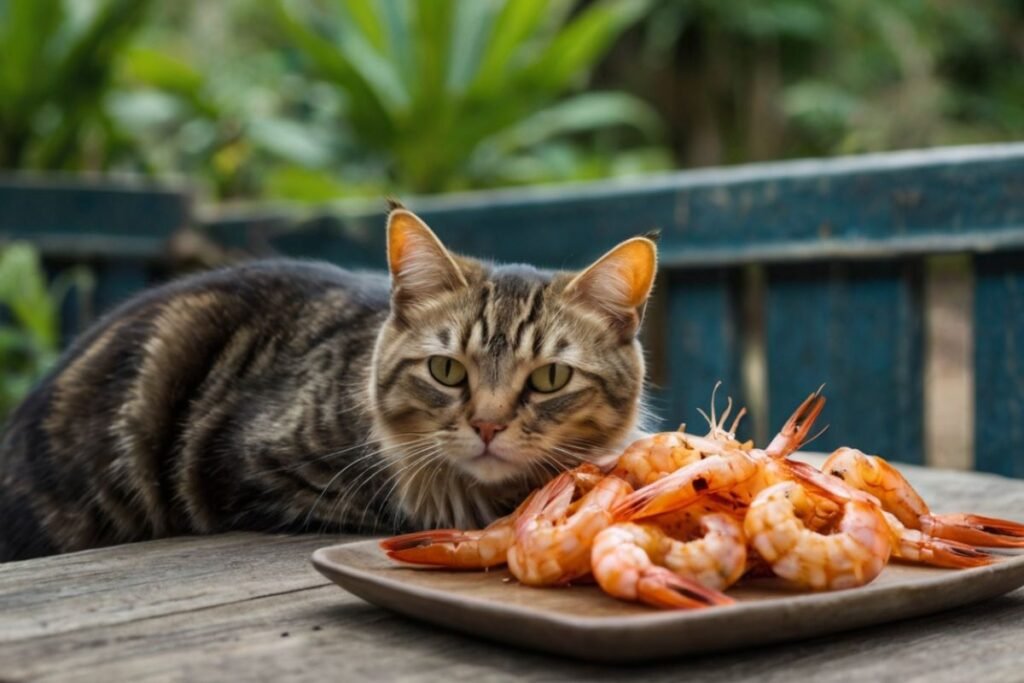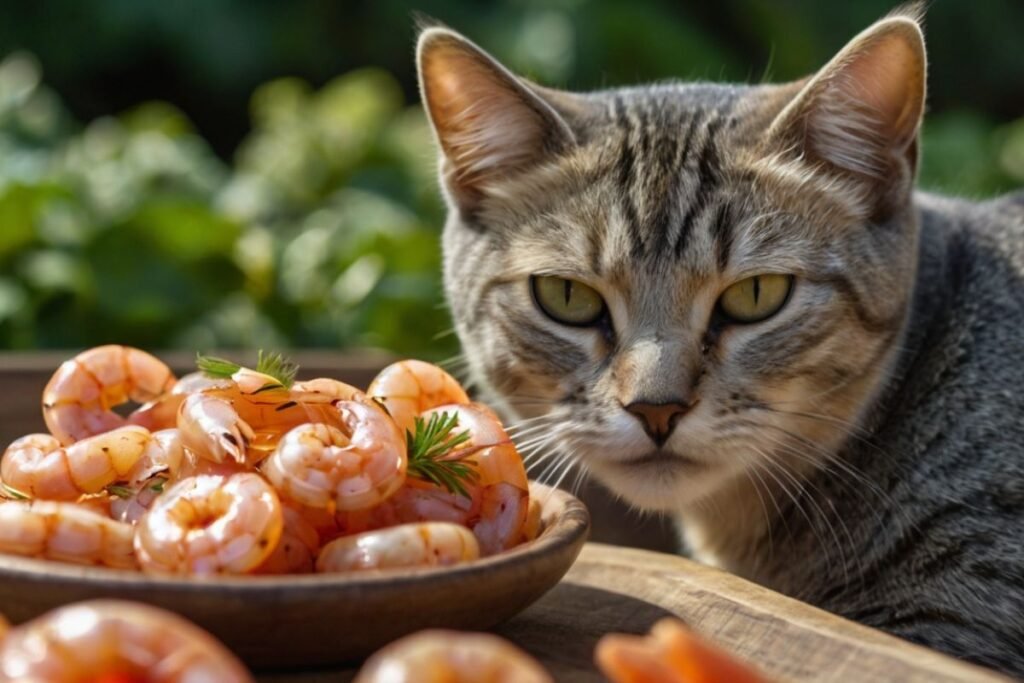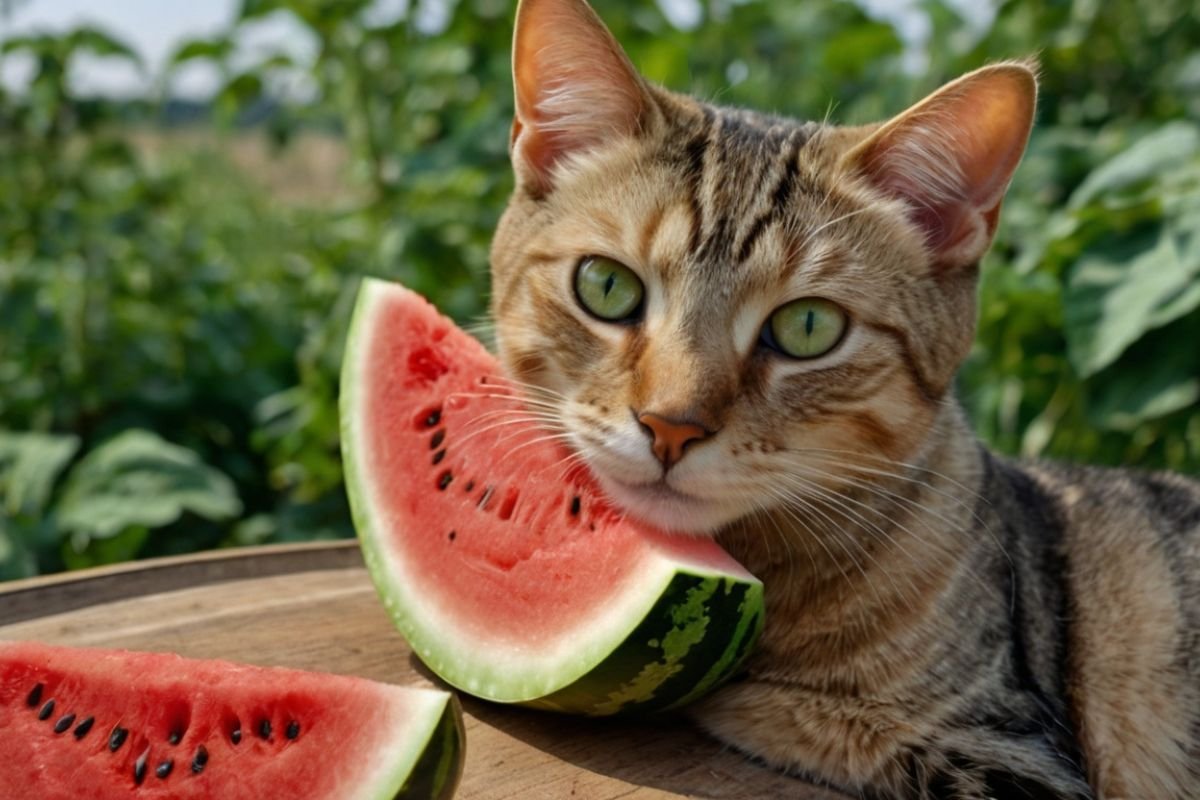Oh my gosh, let me tell you about the time I almost poisoned my cat with shrimp! Okay, maybe “poisoned” is dramatic, but Rio definitely wasn’t happy with me. Picture this: I’m making shrimp scampi for dinner, and my adorable orange fluffball is doing his usual kitchen dance. You know the one – where they weave between your legs and give you those eyes that say “I’m starving and you’re the worst parent ever.”
So naturally, I caved. I mean, who doesn’t want to spoil their fur baby? Big mistake. Huge. But hey, that’s how I learned everything I’m about to share with you!
Table of Contents
The Night Rio Taught Me About Shrimp (The Hard Way)
Picture my two-year-old orange tabby Rio. He’s got this personality that’s bigger than his chunky little body. When I started cooking that shrimp, he planted himself right next to me and started his dramatic “I’m dying of hunger” performance. His meowing got louder and more pitiful by the minute.
Being the softie I am, I thought, “What’s the harm in one little shrimp?” Famous last words, right? I gave him a whole shrimp – shell, tail, and all the garlic butter goodness. He wolfed it down like he hadn’t eaten in weeks. Then he looked at me with those big eyes asking for more.
Three hours later, I’m cleaning up cat vomit from my carpet. Rio looked miserable, and I felt like the worst cat parent in the world. That’s when I realized I had no clue what I was doing. Time for some serious research!
Why Cats Go Absolutely Bonkers for Shrimp
After my epic fail, I started wondering why Rio was so obsessed with shrimp. Turns out, it’s not just him being dramatic (though he is that too). Cats are hardwired to love seafood. Back in their wild days, they’d catch fish and little sea creatures. Shrimp basically screams “PREY!” to their ancient cat brains.
The smell alone drives them nuts. I swear Rio can smell shrimp from three rooms away. The second I open a bag of frozen shrimp, he materializes like a furry little ghost. It’s like he has shrimp radar or something!
Plus, shrimp has this perfect chewy texture that cats love. It’s soft enough for their little teeth but still gives them something to really sink into. Rio treats each piece like it’s a tiny mouse he caught himself. Sometimes he even carries pieces around the house like trophies!
What Makes Shrimp Actually Good for Cats

Here’s what surprised me during my post-vomit research session: Shrimp is actually pretty healthy for cats! I know, right? Who knew my mistake could have been educational?
First off, it’s loaded with protein. Cats need tons of protein – way more than dogs or humans. Shrimp delivers that protein punch without a lot of extra junk. Rio’s always been a picky eater with his regular food, so I was happy to find something nutritious he actually wanted.
Then there’s all these omega-3 fatty acids. These little guys keep your cat’s coat shiny and their brain sharp. I’ve noticed Rio’s fur looks extra glossy after his shrimp treats. Maybe it’s coincidence, but I’m taking credit for it!
Shrimp also has selenium and vitamin B12. Don’t ask me to explain exactly what these do because I’m not a vet, but my research said they’re good for cats. Something about antioxidants and nervous system health. Sounds important, right?
But here’s the thing – and this is super important – shrimp can’t replace actual cat food. I learned this the hard way when Rio started turning his nose up at his regular kibble. Shrimp is like candy for cats. It’s a treat, not a meal.
Also read, Can Cats Eat Cucumbers?
How I Finally Learned to Prepare Shrimp Right
After the Great Shrimp Disaster of 2023, I became obsessed with doing it right. I probably spent three hours reading about proper shrimp preparation for cats. My boyfriend thought I’d lost my mind, but hey, Rio’s worth it!
First rule: cook that shrimp properly! Raw shrimp can have all sorts of nasty bacteria. I learned this after imagining all the horrible things that could have happened to Rio. Now I boil shrimp until it’s completely pink. No shortcuts, no maybes.
Second rule: remove EVERYTHING. Shell, tail, that weird black vein thing – it all has to go. Cats can’t digest shells, and they can cause serious problems. I now inspect each piece like I’m defusing a bomb. Rio sits there watching me like I’m preparing his royal feast.
Third rule: keep it boring. No garlic, no butter, no seasonings. Just plain, cooked shrimp. I know it seems sad, but cats don’t need all that extra stuff. Plus, garlic is actually toxic to cats. Who knew? (Well, everyone except me, apparently.)
My method now is super simple. I boil water, drop in the shrimp, cook until pink, then let it cool completely. Rio prefers his shrimp at room temperature anyway. He’s picky like that.
The Great Portion Size Experiment
Figuring out how much shrimp to give Rio was like solving a puzzle. After the vomit incident, I was terrified to give him any. But those sad orange eyes wore me down eventually.
I started with just a tiny piece. Like, ridiculously tiny. Rio looked at me like I was insulting his intelligence. But he ate it, and more importantly, he kept it down! Progress!
Now I give him one or two small pieces, maybe twice a week. I know it doesn’t sound like much, but trust me, Rio acts like he’s won the lottery every time. He does this little happy dance that melts my heart.
I read somewhere that treats should only be 10% of your cat’s daily calories. Math isn’t my strong suit, but I figure a couple shrimp pieces can’t be too bad. Rio’s regular food does the heavy lifting nutrition-wise.
Red Flags That Made Me Nervous
Living with Rio has taught me to watch for warning signs. Some cats are allergic to seafood. I had no idea this was even a thing! Now I watch for vomiting, diarrhea, or weird skin reactions. If I see any of these, no more shrimp.
Shrimp is also high in cholesterol. Rio’s only two and healthy, so I’m not worried yet. But I know older cats or ones with heart problems should probably skip the shrimp treats.
I also learned about farm-raised versus wild-caught shrimp. Apparently, farm-raised can have antibiotics and chemicals. I try to buy wild-caught when I can afford it. Rio’s worth the extra cost, even if he doesn’t appreciate my sacrifice!
When I Have to Say No
There are times when even Rio’s most pathetic begging doesn’t work. If a cat has food allergies, shrimp could be dangerous. I’d start with the tiniest amount possible and watch like a hawk.
Cats with kidney problems should avoid shrimp because of the sodium. I’m lucky Rio’s healthy, but I know some cat parents deal with these issues. Always check with your vet if you’re not sure.
Baby kittens shouldn’t have shrimp either. Their little tummies are still figuring out regular kitten food. I’d wait until they’re at least six months old before trying any treats.
Diabetic cats need special consideration too. While shrimp doesn’t have carbs, it’s still extra calories. I’d definitely talk to a vet about this one.
Creative Ways I Spoil Rio with Shrimp
I’ve gotten pretty creative with Rio’s shrimp treats. Sometimes I chop tiny pieces and mix them with his regular food. Suddenly, boring kibble becomes exciting! It’s like adding bacon bits to a salad.
On hot summer days, I freeze small pieces of cooked shrimp. Rio loves these frozen treats! He bats them around like toys before eating them. It’s entertainment and snack time rolled into one.
I also use shrimp for training. Rio learned to sit pretty quickly when shrimp was involved. Those little pieces are perfect motivation for learning new tricks. Much better than regular training treats!
My latest trick is making shrimp paste. I mash cooked shrimp with a tiny bit of water and spread it on his puzzle feeder. Rio spends ages trying to get every bit out. Mental stimulation and yummy treats – win-win!
Store Treats vs. The Real Deal
Pet stores sell shrimp-flavored everything these days. I’ve tried some of these with Rio, and he likes them okay. But they’re usually full of artificial flavors and preservatives. I prefer giving him real shrimp when possible.
Some fancy cat foods include real shrimp in their recipes. These are probably fine, but they’re expensive! I stick with regular good-quality cat food and use real shrimp as special treats.
I avoid human shrimp products completely now. Things like cocktail sauce or breaded shrimp have ingredients that could hurt cats. I learned this lesson the hard way, remember?
How Shrimp Compares to Other Seafood
Rio’s not just obsessed with shrimp. He goes crazy for salmon and tuna too. Each type of seafood has pros and cons though.
Salmon is really rich in omega-3s. It’s great for cats when cooked properly. But it’s higher in calories than shrimp, so I have to be more careful with portions. Rio doesn’t care about calories, but I do!
Tuna is another favorite. It’s high in protein and relatively low in calories. But too much tuna can cause mercury poisoning. I limit tuna treats more than shrimp ones.
I’ve tried crab with Rio too. It’s similar to shrimp but more expensive. Plus, it’s harder to remove all the shell pieces. Rio’s not picky enough to justify the extra cost and effort.
All My Embarrassing Mistakes
I’ve made so many mistakes with Rio and shrimp. That first disaster was just the beginning! Let me save you from my embarrassment.
I gave him way too much at first. This caused digestive problems and made him feel awful. Now I stick to tiny portions no matter how much he begs.
I didn’t cook shrimp thoroughly in the beginning. Raw or undercooked shrimp can have harmful bacteria. I always cook until completely pink now, even if it seems overdone.
I forgot to remove a piece of shell once. Rio tried to eat it but thankfully spit it out. Now I check every piece three times before serving.
I added garlic butter early on. Rio loved it but got sick later. I learned to serve plain, boring shrimp only. He’s gotten used to it.
I also gave shrimp too often initially. Rio became picky about his regular food. I had to scale back to keep his diet balanced. Now it’s a special treat, not a daily thing.
When I Panic and Call the Vet
There are times when I don’t mess around with home remedies. If Rio shows any signs of allergic reaction, I call the vet immediately. Vomiting, diarrhea, difficulty breathing, or skin irritation all mean emergency time.
Luckily, Rio’s healthy and young. But if your cat has kidney disease, heart problems, or diabetes, check with your vet first. They might need special dietary restrictions.
If you’re unsure about portion sizes, ask your vet. They can help determine appropriate amounts based on your cat’s size and health. I wish I’d done this from the start!
Also, if your cat refuses regular food after trying shrimp, consult your vet. Some cats become picky eaters after trying exciting new foods. Rio went through this phase, and it was stressful!
What Two Years of Shrimp Feeding Taught Me
After two years of giving Rio shrimp treats, I feel like an expert. Well, maybe not an expert, but at least I haven’t poisoned him lately! Here’s what I’ve learned:
Shrimp can be safe and healthy for most cats. But preparation and moderation are absolutely crucial. I always cook thoroughly and serve plain. I remove all shells and tails completely. I keep portions small and frequency limited.
Most importantly, I remember that treats are extras. They don’t replace regular cat food. High-quality cat food provides the balanced nutrition cats need daily. Shrimp is just the cherry on top.
Every Cat Is a Special Snowflake

What works for Rio might not work for your cat. I started slowly with tiny amounts and watched his reaction carefully. This approach helped me avoid major disasters.
If your cat enjoys shrimp and shows no problems, continue giving it occasionally. But if issues arise, stop immediately. Trust your gut – you know your cat better than anyone.
Some cats are more sensitive than others. Some have allergies or health conditions. Some are just drama queens who act sick for attention. (I’m looking at you, Rio.) The point is, every cat is different.
My Honest Dad-to-Dad Advice
Sharing food with our cats feels so natural. We want to include them in everything we do. Shrimp can be part of this bonding when done safely.
The key is learning from others’ mistakes instead of making your own. I made plenty of mistakes, so you don’t have to! Understanding risks and benefits helps you make smart decisions.
Most importantly, your cat’s health comes first. While treats are fun, they should never compromise wellbeing. A healthy cat is a happy cat, and a happy cat makes for a happy cat parent.
From One Crazy Cat Parent to Another
I hope sharing my Rio adventures helps you make good decisions about shrimp. He’s enjoyed his shrimp treats for two years without major problems. This happened because I learned from my epic fails.
Start small if you decide to try shrimp. Watch your cat like a hawk. Follow safe preparation methods. Keep portions tiny and frequency limited. When in doubt, don’t risk it.
Whether you’re new to cat parenting or have years of experience, we’re all still learning. Making mistakes is part of the journey. What matters is learning from them and doing better next time.
Rio’s currently sprawled across my keyboard while I finish writing this. He’s probably dreaming about shrimp, the little weirdo. But he’s healthy and happy, which makes all the research and careful preparation worth it.
Your cat will love you for the effort, even if they can’t say it. Well, they might say it in their own special way – like knocking things off your counter or bringing you dead mice. That’s love in cat language!
Remember, we’re all just doing our best for our furry overlords. Some days we nail it, some days we clean up vomit. That’s life with cats, and honestly, I wouldn’t have it any other way.

Shahriar Robin is the creator of WhatPetsCanEat.com, a passionate pet lover and dedicated cat dad to Rio, a curious two-year-old orange feline who inspired this website. With a love for animals and a knack for research, Shahriar shares trusted, easy-to-understand information to help fellow pet owners make safe, healthy food choices for their furry friends.


